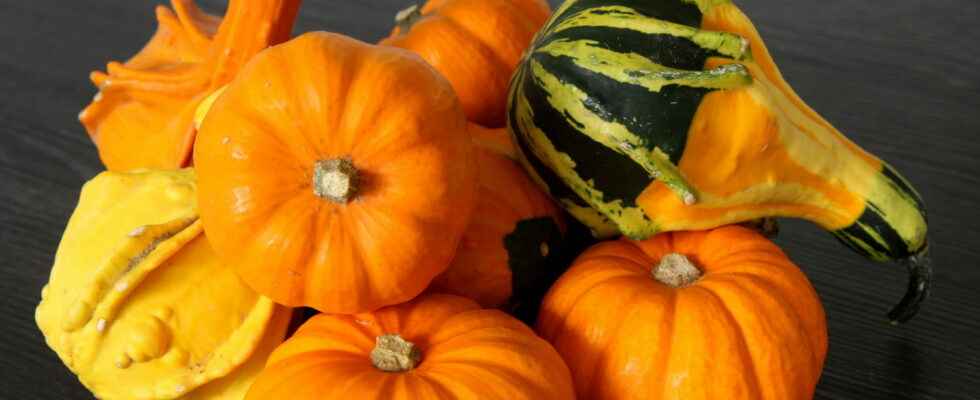Pumpkins, pumpkins, butternut and other cucurbits are not all edible and some can even be poisonous. How to recognize them? Which one is safe to eat? Photos and tips to avoid poisoning.
Pumpkin, pumpkin, butternut squash, squash… These cucurbits are good for your health and bring color, especially in our autumn dishes! But beware, some gourds are toxic. Bitter or wild gourds can even cause serious food poisoning and should not be ingested. reminded the National Agency for Food, Environmental and Occupational Health Safety (handles) end of October 2022. The confusion between edible gourds and wild gourds represents the 3rd most common confusion, after the confusions of plants with poisonous bulbs with edible bulbs and the confusions of horse chestnut with chestnuts. How make the difference and no longer confuse them? How to avoid the risks and consume them without danger?
What are the differences between pumpkins?
| Type of squashes | Aspect | Taste and flesh | Edible or not? |
|---|---|---|---|
| Pumpkin | Round shape Orange color Rough and fibrous stem | Mild, slightly sweet taste and stringy flesh | Edible |
| Pumpkin | Round, oval or flattened shape depending on the variety Color ranging from orange to dark green Soft and spongy stem | Mild, sweet taste and smoother flesh than pumpkin | Edible |
| Pumpkin | pear shape Dark orange, bronze or red color | Chestnut flavor and mealy flesh | Edible |
| squash | Serrated and slightly domed shape Smooth, orange or white skin White or light green color | Slightly sweet taste of artichoke base and dark yellow floury flesh | Edible |
| butternut | Very elongated pear shape Matte skin (not shiny) and very thin Light orange color | Mild chestnut or hazelnut flavor and creamy flesh | Edible |
| Non-edible gourds or gourds | Spherical or ovoid, egg or pear shape Smooth or warty bark | Very bitter taste and green, whitish or yellow flesh | Inedible |
Which gourds are poisonous and which cannot be eaten?
The “gourds” toxic contain cucurbitacins, “very irritating and bitter substances which can be responsible quickly after ingestion for digestive pain, nausea, vomiting, sometimes bloody diarrhea, even severe dehydration requiring hospitalization“, warns ANSES. Those substances, which are not destroyed by cookingare naturally made by wild gourds to repel caterpillars and other predatory insects. Two types of squash are poisonous:
► Ornamental gourds such as gourds which are sold commercially, sometimes in the fruit and vegetable department for decorative use only should not be confused with edible squash.
► Edible squash grown in a vegetable garden. They may become unfit for consumption as a result of wild hybridization. “VShe phenomenon occurs when bitter varieties and edible varieties coexist, in the same vegetable garden or in neighboring vegetable gardens, and the seeds are harvested and sown from year to year.“, describes ANSES. These squashes have a bitter taste unlike edible squashes which have a neutral or slightly sweet taste.
Pictures of inedible gourds
What squashes are eaten?
You can eat pumpkin, pumpkin, butternut squash, pumpkin and squash. To avoid poisoning: if you taste a piece of raw squash and the taste is bitter, spit it out and throw the squash away: it is poisonous and should not be eaten even cooked.
Pictures of edible gourds
Conversely, edible squash have a neutral or slightly sweet taste.
What are the symptoms of squash poisoning?
A small amount of squash swallowed is enough to cause symptoms that usually appear shortly after ingestion:
- vomiting,
- sometimes bloody diarrhoea,
- intestinal cramps,
- dizziness,
- profuse salivation,
- heartbeat,
- dehydration…
If one or more disorders appear following consumption of squash, immediately call your nearest poison control center or seek medical attention. In the event of a medical emergency (profuse digestive bleeding, loss of consciousness, etc.), go directly to the emergency room or call 15 or 112. It is very important to mention to your interlocutor that you have eaten squash, specify the time of the last meal, the time of onset of the first signs as well as a precise description of the symptoms.
- If in doubt, taste a small piece raw : if the taste is bitter, spit it out and throw the squash in the trash because it means that it is not edible, even cooked. If the taste is neutral or slightly sweet, the squash is edible.
- Photograph the squash before consumption to allow better identification of the species consumed.
- Save leftover meals (soup, mashed potatoes, etc.) which could possibly be useful for researching toxic substances in the squash consumed.
- Do not eat wild squash which grow “spontaneously” in a garden.
- Do not collect seeds from previous harvests to resow them. Buy new seeds with each new seed to plant them in your vegetable garden.
- Ornamental gourds (gourds) are all poisonous and should not be eaten. When you buy it, check the label or ask for advice to vendors at the point of sale.
Sources: This year again, watch out for bitter gourds, ANSES on October 27, 2022 and the Belgian Poison Center.





